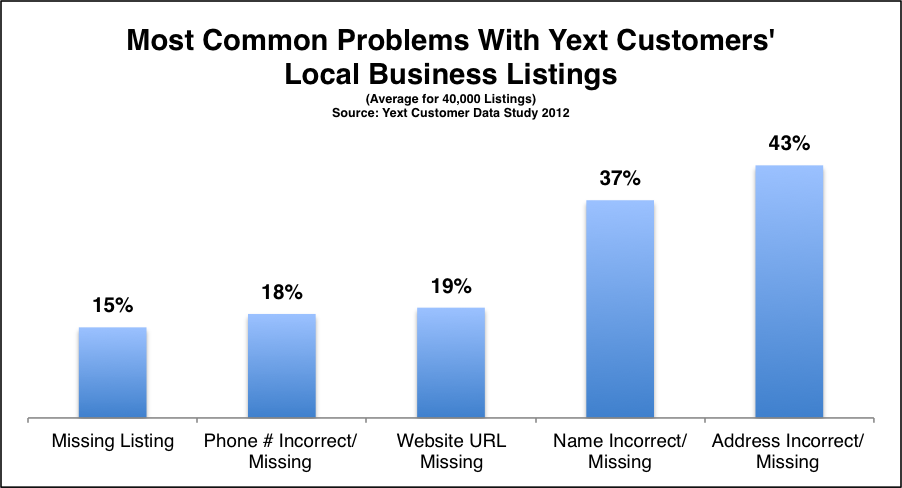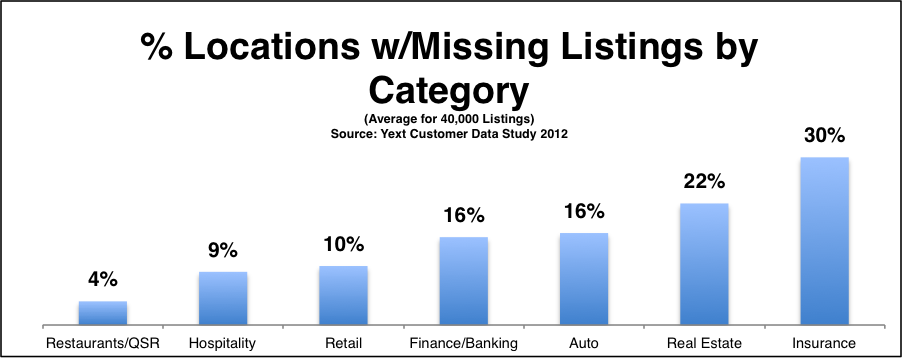The Most Common Problems With Local Business Listings
Two weeks ago, Greg Sterling and I published “YQ,” a study on the state of location data for Yext, where we discovered (surprise!) that the state of business location data on the Web is pretty messy. The study provided us with the opportunity to look at patterns among thousands of Yext’s customers, and I thought […]
Two weeks ago, Greg Sterling and I published “YQ,” a study on the state of location data for Yext, where we discovered (surprise!) that the state of business location data on the Web is pretty messy. The study provided us with the opportunity to look at patterns among thousands of Yext’s customers, and I thought it would be of interest to share some more detail on what we saw in that data.
In the December 2012 YQ Survey, we found that consumers regularly encounter incorrect location data for businesses. It’s clearly a big problem, not only for consumers, but also for marketers.
Given that this is such a critical issue to getting your business found, we decided to see what kinds of issues were most common among Yext customers. After all, it’s hard to solve the problem until you know what the problem is.
We looked at 40,000 U.S. business listings, the majority of which are for multi-location businesses. Not surprisingly, the data shows that location data for these businesses has a large amount of inaccuracies and omissions:
Across 40,000 Yext customer listings, 43% had at least one incorrect or missing address on the 50+ local directory sites in Yext’s network. Approximately 37% had at least one incorrect or missing name on a listing.
When we looked at the numbers by business category; we noticed the following trends across Yext’s top customer categories: Insurance Agents and Real Estate Agents were the most likely types of businesses to have missing listings in Yext’s network.
This makes sense, given that there are a number of independent operators in these niches, and these agents often move around from company to company. Many of these agents may use their home as locations, which makes it less likely that these listings would show up in traditional business listing data sources.
Insurance Agents and Real Estate Agents also were the top categories with missing or incorrect business names on their local directory listings, along with Hospitality businesses. Each of these categories had over 50% of their locations with incorrect name data. For Real Estate and Insurance, this is also likely due to the difficulty of dealing with independent agents.
For Hospitality, this may be an issue where a corporation and its local representative use different names for the same business. For example, Hilton may call a hotel the Hilton Express at SFO, while the local hotel might use SFO Hilton Express. This discrepancy would show up as an error when comparing the two.
Many of the top categories had a relatively high degree of missing or incorrect address information for their business locations. Over 40% of listing addresses checked for the top five categories had this problem.
Finance/Banking showed the highest likelihood to have bad data for location phone numbers with 41% of listings showing a problem. This is likely due to these institutions using both toll-free and local numbers in their listings data. Inconsistent use of phone numbers can cause both SEO problems and consumer confusion.
While missing or incorrect phone numbers is probably the most egregious error when it comes to displaying business location information; in 2013, not providing a link to your website is almost as bad.
While local directories can do a pretty good job of providing key information about your business, allowing consumers to do a deeper dive by visiting your website can be a strong driver of conversions – assuming your website is set up to convert.
Your website can also be helpful in creating more of a connection with potential customers by providing them with more info on your services and making it easy to find your social media profiles where you share additional information. Again, the categories that are biased toward local independent operators were the most problematic with almost one-quarter of their listings missing website links. Surprisingly, Retail was also one of the top categories here, missing out on a critical component of connecting online and offline sales.
In some ways, this data is no surprise. Local business data on the Web has always been a mess, suffering from a combination of marrying conflicting information from multiple sources and lack of awareness by the businesses themselves. But with so many tools now available for businesses to control this information, it is surprising that the data consistency problem is still so common.
Disclosure: The author has a consulting relationship with Yext.
Opinions expressed in this article are those of the guest author and not necessarily Search Engine Land. Staff authors are listed here.
Related stories





